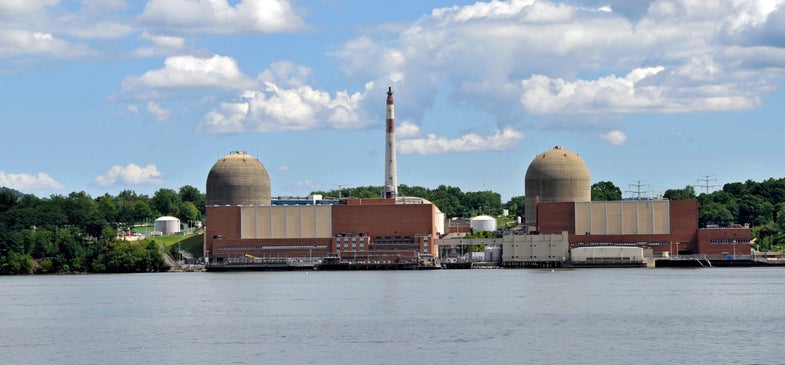What You Need To Know About Indian Point Nuclear Plant’s Groundwater Alert
Don't panic

Indian Point Energy Center, an aging nuclear power plant located just 25 miles away from New York City, recently detected elevated amounts of radiation in groundwater near the plant, according to news alerts published on Saturday by the facility’s parent company Entergy and by New York Governor Andrew Cuomo.
It sounds scary, and in some ways it is — figuring out how the radiation got into the groundwater is a mystery that needs solving. But there isn’t any immediate danger to public health.
As Entergy’s statement reads (in part):
Gov. Cuomo’s statement tried to strike a balance between concern and reassurance:
He also said he directed the New York Commissioners of Environmental Conservation and Health to begin an investigation into the incident.
Tritium is a radioactive isotope of hydrogen. It’s present in the environment naturally in very small amounts, but can also be created by nuclear power plants. It can’t travel very far in air, but it can combine with oxygen to create water, just like normal hydrogen. This resulting water is called tritiated water, and can mix with regular water easily. That’s what was found in the monitoring wells at Indian Point.
The water in the wells isn’t used for drinking, but even if it was, tritiated water isn’t considered a huge health concern, especially in extremely low doses. Because it acts just like other forms of water: it goes into soft tissues, and is generally expelled from the body quickly, in a matter of days.
That doesn’t mean that people aren’t paying attention to the issue. Nuclear power plants aren’t supposed to leak. Even if they aren’t leaking glowing green sludge, it’s something that people want to monitor. But tritium leaks happen more often than you might think. Of the 65 nuclear power plants (past and present) in the United States, 46 have reported tritium leaks into groundwater in excess of the 20,000 picocurie per liter limit set by the EPA as the safe amount in drinking water. There are 13 total power plants that are currently reporting levels of tritium larger than the EPA limit, but none have detected that amount in any drinking water.
A picocurie is one-trillionth of a Curie, a measure of radioactivity. For comparison, a routine thyroid test uses about one millionth of a curie, a much larger dose.
The cause for the urgency at Indian Point is that the amount of tritium in the water suddenly increased, jumping from 12,300 picocuries per liter, to over 8 million picocuries per liter. Again, that isn’t in any drinking water supplies, and hasn’t been detected outside of the power plant property. But given that water generally doesn’t observe property boundaries or “no trespassing” signs, the plant managers and government officials do need to be keeping an eye on the situation.
The Indian Point power plant has two currently operating nuclear reactors, which went online in 1974 and 1976 respectively. They provide 25 percent of all the power used in New York City and Westchester county. To give a sense of scale, a total of 9.37 million people live in New York City and Westchester combined.
Another nuclear reactor at the Indian Point site operated from 1962 to 1974 before being shut down due to a cooling system that didn’t meet regulatory standards. In the past, leaks of tritium and strontium-90 into the groundwater have both been traced to this now-defunct reactor. Spent fuel was removed from the reactor forty years ago in 1976, but Entergy is still monitoring the building near where the spent fuel was stored.